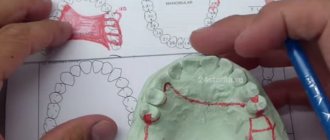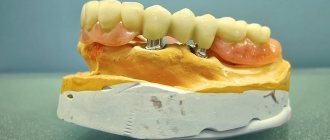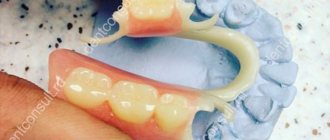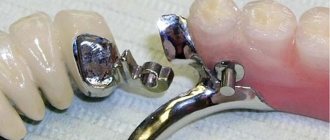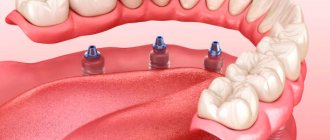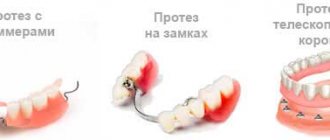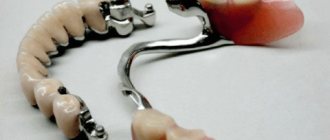Losing molars is an inevitable event that occurs in the life of every person. Only the reasons for this process and the age criteria of people differ. As sad as it may be, the process of tooth loss is irreversible.
To eliminate problems of this kind, dental/dental prosthetics are used.
There are many different types of structures for prosthetics. In dentistry, the production of clasp dentures is popular, the cost of which is affordable for the general public. The products have interesting design features, thanks to which the chewing load is evenly distributed through the periodontium of the tooth, as well as the mucous membrane of the prosthetic bed.
The supports for this design are:
- gums;
- natural teeth;
- jaw body;
- sky;
- alveolar processes.
In fact, the device consists of the following main parts: a clasp denture frame, fastening, a base with fake teeth, and a retaining arch.
Types of clasp dentures
If you pay attention to the photo of clasp dentures, you can see that they are all different from each other. The main difference is the type of fastening:
- splinting clasp prosthesis;
- castle;
- clasp;
- telescopic.
The fixation of such prostheses also differs depending on the clinical indications. There are several types of fixing elements, the choice of which is made by the dentist for each individual case.
There are circumstances when a patient needs upper and lower dentures. The most popular are acetal-based designs. This is due to the fact that the material (soft plastic) is more elastic and can have different colors (colorless, white, pink). The price of an acetal-based clasp prosthesis differs from a design with metal fixation. In addition, the products are more flexible than those made on a metal base.
Two functions performed by clasp dentures are splinting and dental prosthetics. With the help of such structures, it is possible to restore the structure of the dentition, as well as provide a preventive effect aimed at preserving healthy teeth.
Implant support
I would like to pay special attention to the beam fixation system supported by implants - a new word in removable prosthetics.
In the absence of favorable conditions for fixing removable dentures, an alternative to a fixed bridge is a removable denture, which is installed on implants. A complete removable denture supported by a ball or bar structure, which in turn is supported by two or more implants in the anterior jaw. (see picture)
Implants help keep the denture in place and provide better functionality and comfort. Implants can serve as a support for the fixing elements of a removable denture.
In the absence of teeth, especially in the lower jaw, it is not easy to achieve good fixation of a complete removable denture. But this problem can be solved with the help of several implants. At the end of the healing process, the implants serve as a support for the beam fastening of the removable denture. The production of such a structure takes place in a dental laboratory and requires the highest qualifications and precision from the dental technician. The beam is fixed to the implants and is a non-removable part of the combined prosthesis. The second (reciprocal) part of the beam fastening is fixed in the prosthesis. Thus, the prosthesis “snaps” onto the beam and is securely held in place.
Our team of doctors
Maxillofacial surgeon, Implantologist
Bocharov Maxim Viktorovich
Experience: 11 years
Orthopedist, Neuromuscular dentist
Stepanov Andrey Vasilievich
Experience: 22 years
Endodontist, Therapist
Skalet Yana Alexandrovna
Experience: 22 years
Orthopedic dentist
Tsoi Sergey Konstantinovich
Experience: 19 years
Endodontist, Therapist, Orthopedist
Varvyanskaya Anastasia Andreevna
Experience: 6 years
Dentist-orthodontist
Enikeeva Anna Stanislavovna
Experience: 3 years
A few words about product care
The storage of clasp dentures and the preservation of their appearance, as well as performance characteristics, are inextricably linked with proper care. What needs to be done to ensure that the clasp always looks like new and lasts for many years, we will tell you further:
- cleaning the denture 2 times a day using a special brush and paste,
- disinfection in a solution once every 7-10 days (on the recommendation of a doctor, a short soak in the solution can be carried out daily),
- high-quality cleaning of your own teeth: so that plaque and germs from them do not get onto the artificial “jaw”,
- rinsing your mouth with clean water after every meal,
- It is recommended to purchase an irrigator and an ultrasonic bath for better hygiene,
- refusal of hard products: they can leave scratches on the base or break it, damage metal fasteners, lead to “misalignment” of the arc,
- avoidance of stretchy products: they can disrupt the connection of different elements of the prosthesis,
- visits to an orthopedic dentist for preventive examinations 1-2 times a year.
It is forbidden to clean the clasp denture with highly abrasive toothpaste, with a brush with very hard bristles, or soak it in aggressive solutions - for example, in vinegar.
Fastenings for clasp dentures
Removable clasp dentures are also called conditionally removable. This is because to remove them you have to make a significant effort using a key, thanks to which you can unlock the micro-lock mount.
Clasp clasp dentures are characterized by strong and reliable fixation. This system is attached to the molars thanks to prosthetic hooks that cover the entire crown. Clasp fastenings do not loosen the teeth on which they are fixed, and this is a huge advantage.
Castle - consists of several parts. These parts interact with each other to form a system. To use such a system, special crowns are placed, in which the main part of the structure is located. The advantages of this type of fastening are that it is not visible to the interlocutor during a conversation.
The most troublesome and complex fixation system is telescopic. Here the main point of support is telescopic crowns. They are attached to the tooth and denture. Such a system requires mandatory correction over time.
Prices
Average prices in private dentistry:
- design with 2 dental crowns – 35,000 rubles;
- design with 4 crowns – 45,000 rubles;
- one-sided prosthesis – from 30,000 rubles;
- device for the entire jaw - about 50,000 rubles.
Additionally, you will have to pay for taking dental impressions - 1000 rubles. These casts are needed to make a plaster model of the jaw, which will be used to make an individual design. The production time for the device is 12-14 days.
If you are looking for a dentistry with optimal prices for dental prosthetics, we suggest using the information on our website. The largest database of specialized institutions is collected here.
How to care for partial dentures?
Of course, installing a clasp mechanism is not everything. A mandatory requirement is to maintain the oral cavity in proper hygienic condition. Some care is required directly for the structure itself. It is necessary to remove plaque and food debris from the denture every morning and evening. It is worth paying attention to the question of whether to remove the prosthesis while sleeping at night or not. The fact is that people suffering from diseases of the oral cavity and who have indications for constantly wearing a denture as a therapeutic measure need to remain in it even during rest.
As a rule, the structures do not cause discomfort, as they are lightweight and fit perfectly in the mouth.
Innovations in dental prosthetics make it possible to restore abnormal dental functions, mask defects in the dentition, and prevent possible future changes.
Author:
What affects the wear of materials and elements
The artificial materials from which clasp dentures (and any others) are made cannot be independently renewed and restored, like natural fabrics. We are talking about the natural process of enamel remineralization (calcium saturation) or gum regeneration. Of course, you need to take care of your own teeth and gums, but also artificial ones. What many people forget about, believing that since such “teeth” cannot hurt, then there is no need to care for them. Therefore, some factors can lead to early wear of the orthopedic structure. Let's look at them in more detail:
- poor-quality care: irregular cleaning, an abundance of soft and sweet foods in the diet - combined with the lack of rinsing the mouth after such meals, refusal of professional cleaning 1-2 times a year in a clinic,
- too much force when cleaning: you can scratch the acrylic base or break the fasteners,
- incorrectly selected hygiene products: it can be either a very hard brush or a soft one - the first leaves scratches, the second cannot cope with plaque. Toothpaste with a large amount of abrasive particles also scratches the material, which reduces its service life. Dyes and pieces of food get clogged into microcracks - the material darkens, becomes dull, and may emit an unpleasant odor,
- exposure to harsh chemicals or extreme temperature changes,
- storage in an inappropriate place,
- eating very hard foods, chewing nut shells, etc.
Features of storage of the clasp design
How to store a partial denture outside the mouth, for example, at night or during dental treatment? Ideally, you will not remove it from your mouth at all. But if removal is necessary, it is better to have a special container on hand. Such containers are made specifically for storing removable dentures. Inside the container there may be a holder curved in the shape of a jaw - so that the product does not move inside and does not scratch the walls.
Read on the topic: a container for storing removable dentures - what it can be and which one is better to choose.
After removal, the “clasp” must be cleaned and rinsed with water, gently wiped with a clean napkin and stored in a container. In the same container you can soak in the cleaning solution (if the instructions for the container do not prohibit this). For example, the container can be “double-layered” - with a mesh immersed in the container, and also equipped with an ultrasonic cleaner. For long-term storage, containers with ventilation holes are suitable so that excess moisture can evaporate without problems and not settle inside.
“I stored my bugel in a regular food container. Well, I screwed the lid tightly. Then I realized that I shouldn’t have done this, because... an unpleasant odor appeared. I decided not to close the lid, but I became afraid that someone would sweep the container off the table and the “jaw” would break. Then I decided not to suffer and buy a special case.”
Olga Sergeevna, review from otzovik.com
It is important to place the container with the clasp denture in a suitable place - a shelf in a closet or bedside table is quite suitable. There should be no sources of heat or moisture nearby - a radiator, stove, water tap or humidifier. It is better not to leave the prosthetic structure in the bright sun, because... the material may become discolored. Another danger is posed by sharp objects, unstable massive structures - a hanging shelf with knives, a stack of books, a vase with a bouquet of flowers, etc. Place container behind closed doors, out of reach of small children or pets.
1Gromov O.V. “Lock fastenings in clasp prosthetics, 2010.
Your questions and answers
QUESTION Hello, I’ve been wearing a clasp denture for 2 weeks now, but I still don’t understand how to store it? I put it in water overnight a couple of times, but then I stopped. I don’t remember what the doctor said about this... Evgenia
ANSWER Hello, Evgenia. In general, you don’t even have to remove your clasp denture for now and “store” it directly in your mouth. Because the main task in the first weeks is to get used to the artificial structure. And the more time it “spends” in your mouth, the faster you will get used to it. As for storing clasp dentures in water, absolutely all orthopedic dentists do not advise leaving modern dentures for a long time in any liquid. Maximum – 15-30 minutes a day. Excessive moisture can damage the material, and your prosthesis will quickly become unusable and you will have to make a new one.
Author: Dulgarov Zh. G. (Thank you for your help in writing the article and the information provided)
Which solutions are suitable for storage
Solutions - ready-made liquids or made from water and special cleaning tablets, are suitable only for caring for clasp dentures, but not for storage. Moreover, effervescent tablets are more popular, because take up less space and are more convenient to take with you. To clean the orthopedic structure, manufacturers suggest dissolving the tablet in a glass or container with clean water at room temperature. Then you should place the prosthesis in a container and leave it for 3 to 15 minutes (each brand has its own operating time). Then the “clasp” is removed, cleaned with a brush, washed in running water and dried. After these manipulations, you can install it on the jaw, but the solution must be poured out.
Popular brands of cleansing tablets are Corega, PresiDENT, Protefix, ROCS BONY plus Express, LACALUT DENT Reinigungs Tabs.
